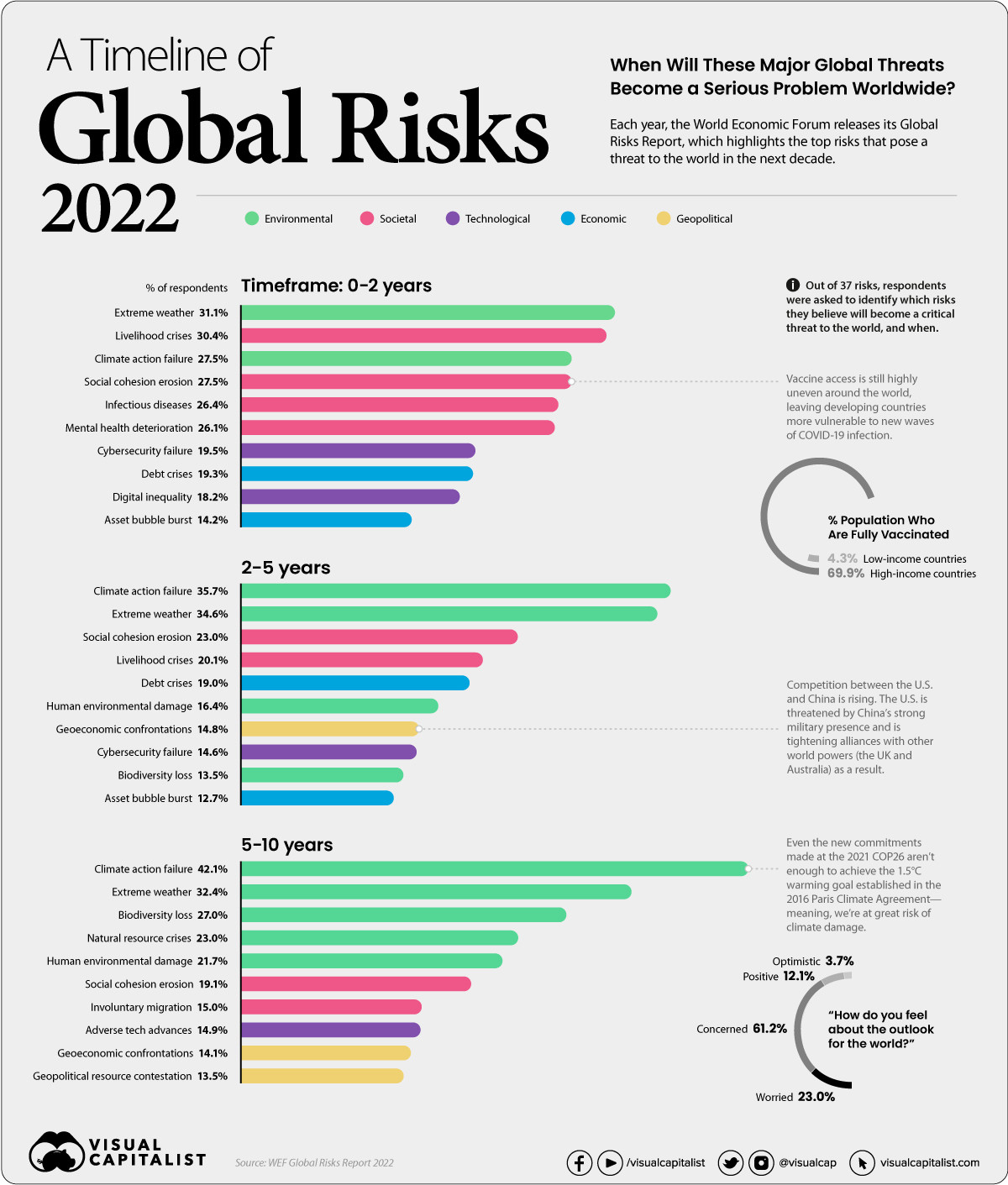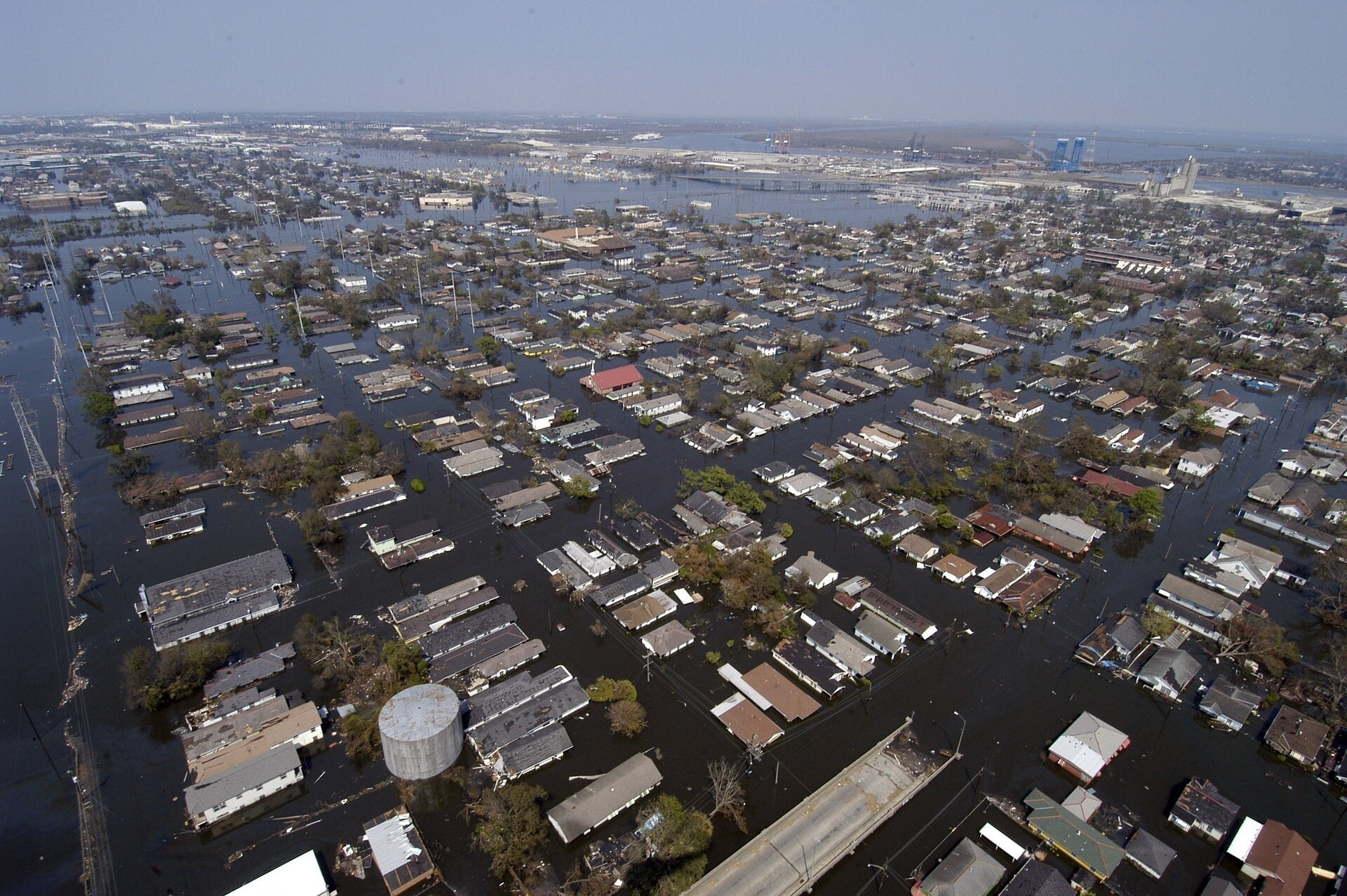Visualized: A global risk assessment of 2022 and beyond

Societal risks have worsened across the globe since COVID-19. Image: UNSPLASH/Ben White

Get involved with our crowdsourced digital platform to deliver impact at scale
Stay up to date:
Pandemic Preparedness and Response
- In the World Economic Forum's latest Global Risks Report, it was found that over 84% of global leaders feel worried or concerned about the outlook of the world.
- The report is split up into short-term, medium-term and long-term threats, in which climate-related factors were considered the biggest risk in each category.
- As we move forward, increased collaboration and consistent reassessment will be vital to mitigate risks against our society, says the report.
Since the start of the global pandemic, we’ve been navigating through tumultuous waters, and this year is expected to be as unpredictable as ever.
In the latest annual edition of the Global Risks Report by the World Economic Forum, it was found that a majority of global leaders feel worried or concerned about the outlook of the world, and only 3.7% feel optimistic.
Ever year, the report identifies the top risks facing the world, as identified by nearly 1,000 surveyed experts and leaders across various disciplines, organizations and geographies.
What global risks are leaders and experts most concerned about, and which ones are posing imminent threats? Let’s dive into the key findings from the report.
Methodology
In the survey, respondents were asked to compare 37 different risks, which were broken down into five categories: economic, environmental, geopolitical, societal and technological.
To get a sense of which risks were seen as more urgent than others, respondents were asked to identify when they believed these threats would become a serious problem to the world, based on the following timeframes:
Short-term threats: 0-2 years
Medium-term threats: 2-5 years
Long-term threats: 5-10 years.
By categorizing global risks into these time horizons, it helps provide a better idea of the problems that decision-makers and governments may have to deal with in the near future, and how these risks may interrelate with one another.
Short-term risks
When it comes to short-term threats, respondents identified societal risks such as “the erosion of social cohesion” and “livelihood crises” as the most immediate risks to the world.

These societal risks have worsened since the start of COVID-19. And as emerging variants threaten our journey towards normalcy, the pandemic continues to wreak havoc worldwide, with no immediate signs of slowing down.
According to respondents, one problem triggered by the pandemic is rising inequality, both worldwide and within countries.
Many developed economies managed to adapt as office workers pivoted to remote and hybrid work, though many industries, such as hospitality, still face significant headwinds. Easy access to vaccines has helped these countries mitigate the worst effects of outbreaks.
Regions with low access to vaccines have not been so fortunate, and the economic divide could become more apparent as the pandemic stretches on.
Medium-term risks
A majority of respondents believe we’ll continue to struggle with pandemic-related issues for the next three years. Because of this, the medium-term risks identified by respondents are fairly similar to the short-term risks.

The pressing issues caused by COVID-19 mean that many key governments and decision-makers are struggling to prioritize long-term planning, and no longer have the capacity to help out with global issues. For example, the UK government postponed its foreign aid target until at least 2024. If countries continue to prioritize themselves in an effort to mitigate the impact of COVID-19, the inequality gap could widen even further.
Respondents also worry about rising debt levels triggering a crisis. The debt-to-GDP ratio globally spiked by 13 percentage points in 2020, a figure that will almost certainly continue to rise in the near future.
What is the World Economic Forum doing to manage emerging risks from COVID-19?
Long-term risks
Respondents identified climate change as the biggest threat to humanity in the next decade.

Climate inaction - essentially business as usual - could lead to a global GDP loss between 4% and 18%, with varying impacts across different regions.
Experts also pointed out that current decarbonization commitments made at COP26 last year still aren’t enough to slow warming to the 1.5°C goal set in the Paris Climate Agreement, so more action is needed to mitigate environmental risk.
That said, efforts to curb climate change and solve long-term issues will likely have negative short-term impacts on the global economy and society. So risk mitigation efforts need to be in place as we work to reach net zero and ultimately slow down climate change.
Risk mitigation efforts
People’s thoughts on risk mitigation were gauged in the Forum survey. Respondents were asked to identify which risks our world is most equipped to handle, and which ones they believe we’re less prepared for.

“Trade facilitation,” “international crime”, and “weapons of mass destruction” were risks that respondents felt we’ve effectively prepared for. On the flip side, “artificial intelligence” and “cross-border cyberattacks and misinformation” are areas where most respondents think we’re most unprotected against.
As society becomes increasingly reliant on digital infrastructure, experts predict we will see an uptick in cyber attacks and cybercrime. New AI-enabled technologies that offer ransomware-as-a-service allow anyone to engage in cybercrime - even those without the technical knowledge needed to build malware.
How do we move forward?
Based on the findings from this year’s survey, the Forum identified five lessons that governments, businesses, and decision-makers should utilize in order to build resilience and prepare for future challenges:
Build a holistic mitigation framework: Rather than focusing on specific risks, it’s helpful to identify the big-picture worst-case scenario and work back from there. Build holistic systems that protect against adverse outcomes.
Consider the entire ecosystem: Examine third-party services and external assets, and analyze the broader ecosystem in which you operate.
Embrace diversity in resilience strategies: Not all strategies will work across the board. Complex problems will require nuanced efforts. Adaptability is key.
Connect resilience efforts with other goals: Many resilience efforts could benefit multiple aspects of society. For instance, efficient supply chains could strengthen communities and contribute to environmental goals.
Think of resilience as a journey, not a destination: Remaining agile and vigilant is vital when building out resilience programmes, as these efforts are new and require reflection in order to improve.
The next few years will be riddled with complex challenges, and our best chance at mitigating these global risks is through increased collaboration and consistent reassessment.
Don't miss any update on this topic
Create a free account and access your personalized content collection with our latest publications and analyses.
License and Republishing
World Economic Forum articles may be republished in accordance with the Creative Commons Attribution-NonCommercial-NoDerivatives 4.0 International Public License, and in accordance with our Terms of Use.
The views expressed in this article are those of the author alone and not the World Economic Forum.
Related topics:
The Agenda Weekly
A weekly update of the most important issues driving the global agenda
You can unsubscribe at any time using the link in our emails. For more details, review our privacy policy.
More on Global RisksSee all
Gareth Byatt and Ilan Kelman
March 11, 2024
Andrea Willige
March 6, 2024
Richard Aster
November 15, 2023
Ian Shine and Rebecca Geldard
November 14, 2023
Andrea Willige
October 26, 2023
Simon Torkington
September 14, 2023








